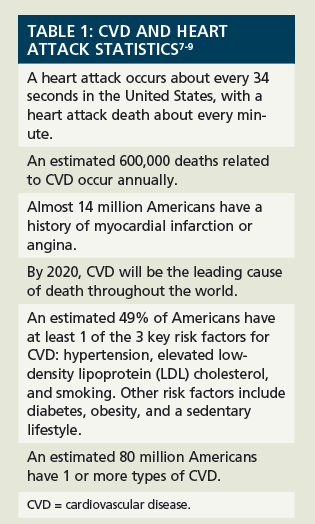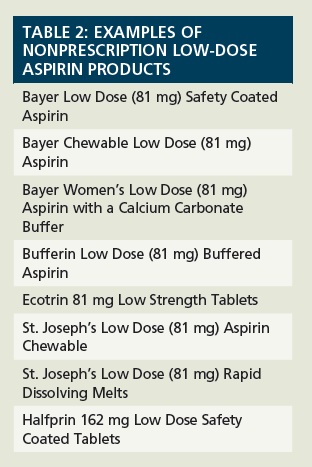Low-Dose Aspirin Therapy and Cardiovascular Health
Cardiovascular disease (CVD) continues to be the leading cause of death in both men and women in the United States, accounting for an estimated 1 in 4 deaths.
Cardiovascular disease (CVD) continues to be the leading cause of death in both men and women in the United States, accounting for an estimated 1 in 4 deaths.

According to recent statistics from the Centers for Disease Control and Prevention, an estimated 720,000 individuals in the United States experience a myocardial infarction (heart attack) every year.1 Low-dose aspirin (acetylsalicylic acid; ASA) regimens continue to be widely recommended by physicians for the prevention of thromboembolic events such as myocardial infarction and stroke in high-risk patients.2-4
Results from various clinical studies report that low-dose ASA therapy has been associated with a decrease in the incidence and risk of death associated with myocardial infarction, unstable angina, transient ischemic attack, and stroke.2-5 Importantly, results from a 2014 study involving 3500 middleaged Americans who did not have CVD but qualified for low-dose ASA therapy based on their CVD risk factors (diabetes, hypertension, smoking, obesity, and the use of antihyperlipidemic drugs) showed that 34% of men and 42% of women in the study were never told about low-dose ASA therapy by their primary health care provider.6 Various health organizations report alarming statistics about CVD, and health care professionals should seize every opportunity to encourage patients—especially those at risk for CVD—to take a proactive role in their overall health and discuss their CVD risks with their primary health care provider (Table 1).7-9
Recommendations Regarding Low-Dose Aspirin Therapy and CVD
The US Preventive Services Task Force (USPSTF) recommends ASA therapy in men aged 45 to 79 years and in women aged 55 to 79 years when the potential benefit of a reduction in myocardial infarction (in men) and ischemic stroke (in women) outweighs the potential harm of an increase in gastrointestinal hemorrhage.10 The task force recommends against the use of ASA for stroke prevention in women younger than 55 years and for MI prevention in men younger than 45 years.10 The USPSTF concludes that current evidence is insufficient to assess the balance of benefit versus harm of ASA therapy for the prevention of CVD in men and women 80 years and older.10
According to the 2014 American Diabetes Association (ADA) Standards of Care, low-dose ASA therapy (75-162 mg/ day) should be considered as a primary prevention strategy in patients with type 1 or 2 diabetes who are at increased cardiovascular risk (10-year risk >10%).11,12 This recommendation includes most men older than 50 years and women older than 60 years who have at least 1 additional major risk factor, such as a family history of CVD, hypertension, smoking, dyslipidemia, or albuminuria.11,12 The ADA Standards of Care also state that low-dose ASA should not be recommended for CVD prevention in adults with diabetes who are at low CVD risk (10-year risk <5%), such as men younger than 50 years and women younger than 60 years with no major additional CVD risk factors, because the potential adverse effects from bleeding likely offset the potential benefits.11,12 Moreover, low-dose ASA therapy can be used as a secondary prevention strategy in diabetes patients who have a history of CVD.11,12
Both the American College of Cardiology and the American Heart Association recommend that individuals at high risk for myocardial infarction should take low-dose ASA daily if recommended by their primary health care provider as long as there are no contraindications.13,14 The American Heart Association also recommends that patients who have had a heart attack discuss the use of low-dose ASA therapy regularly to decrease the risk for or prevent another heart attack.13

Pharmacists are likely to encounter patients seeking guidance about the various low-dose ASA products on the market (Table 2). Currently available products include strengths of 81 and 162 mg in chewable, enteric-coated, and “melt” formulations. Also available are products specifically formulated for women; these include a calcium carbonate buffer in addition to ASA.
Because the risks and benefits of ASA therapy vary from individual to individual, all patients should be encouraged to consult with their primary health care provider before initiating a low-dose ASA regimen to ascertain the appropriateness of therapy. This is especially important for patients with other medical conditions and those currently taking any other medications, including alternative medications. Before recommending a low-dose ASA regimen, it is imperative for pharmacists to evaluate the patient’s allergy history as well as his or her medical and medication history to screen for potential contraindications and drug interactions. Patients with an allergy to ASA or other salicylates and those with a history of stomach ulcers or gastrointestinal bleeding, blood clotting disorders, uncontrolled hypertension, and hepatic or renal disease should avoid the use of ASA and consult their primary health care provider for other possible options.3,15-17
During counseling, patients should be advised about the proper use of ASA products, the potential adverse effects, the importance of adherence, and routine monitoring with their primary health care provider. Patients who consume more than 3 alcoholic drinks daily should not use ASA because of the increased risk for gastrointestinal bleeding.3,15-17 Additionly, because the use of ASA may trigger asthma attacks in some individuals who are sensitive to ASA, these patients should discuss the use of ASA with their primary health care provider.3 Patients should be reminded to alert health care providers, including their physician, dentist, and pharmacist, of their ASA use and to never stop ASA therapy abruptly without first consulting their physician.
Conclusion
Pharmacists can be instrumental in encouraging patients to take a proactive role in their overall health and decrease cardiovascular risks by maintaining a healthy weight, quitting smoking, limiting alcohol use, eating a balanced diet, and exercising routinely. Some excellent patient resources regarding cardiovascular health are listed in Table 3.
Ms. Terrie is a clinical pharmacy writer based in Haymarket, Virginia.
References
1. Heart disease facts. Centers for Disease Control and Prevention website. www.cdc.gov/heartdisease/facts.htm. Updated October 29, 2014. Accessed November 1, 2014.
2. Herlitz J, Tóth PP, Naesdal J. Low-dose aspirin therapy for cardiovascular prevention: Quantification and consequences of poor compliance or discontinuation. Am J Cardiovasc Drugs 2010;10(2):125-141.
3. Remington T. Headache. In: Krinsky D, Berardi R, Ferreri S, et al., eds. Handbook of Nonprescription Drugs. 17th ed. Washington, DC: American Pharmacists Association; 2012.
4. Colwell JA. Aspirin for the primary prevention of cardiovascular events. Drugs Today 2006;42(7):467-479.
5. Kavanagh LE, Jack GS, Lawrentschuk N. Prevention and management of TURP-related hemorrhage: Drugs that increase hemorrhage risk. Nat Rev Urol 2011;8(9):504-514.
6. Fiscella K, Winters PC, Mendoza M, et al. Do clinicians recommend aspirin to patients for primary prevention of cardiovascular disease? J Gen Intern Med 2014;Aug 5 [Epub ahead of print].
7. Heart disease: Scope and impact. The Heart Foundation website. www.theheartfoundation.org/heart-disease-facts/heart-disease-statistics/. Accessed November 1, 2014.
8. Heart attack facts. Women's Heart Foundation website. www.womensheart.org/content/heartattack/heart_attack_facts.asp Accessed October 19, 2014.
9. Heart and stroke statistics. American Heart Association website. www.heart.org/HEARTORG/General/Heart-and-Stroke-Association-Statistics_UCM_319064_SubHomePage.jsp. Accessed November 1, 2014.
10. Final research plan—Aspirin for the prevention of cardiovascular disease: Preventive medication. U.S. Preventive Service Task Force website. www.uspreventiveservicestaskforce.org/Page/Document/ResearchPlanFinal/aspirin-for-the-prevention-of-cardiovascular-disease-preventive-medication1. Accessed November 1, 2014.
11. Executive summary: Standards of medical care in diabetes. American Diabetes Association website. http://care.diabetesjournals.org/content/37/Supplement_1/S5.full. Accessed November 1, 2014.
12. Aspirin for primary prevention in diabetes. Medscape website. www.medscape.com/viewarticle/736151 Accessed October 23,2014
13. Aspirin and heart disease. American Heart Association website. www.heart.org/HEARTORG/Conditions/HeartAttack/PreventionTreatmentofHeartAttack/Aspirin-and-Heart-Disease_UCM_321714_Article.jsp. Reviewed October 20, 2012. Accessed November 1, 2014.
14. Wright RS, Anderson JL, Adams CA, et al. 2011 ACCF/AHA focused update of the Guidelines for the Management of Patients With Unstable Angina/Non—ST-Elevation Myocardial Infarction (updating the 2007 guideline): A report of the American College of Cardiology Foundation/American Heart Association Task Force on Practice Guidelines. Circulation. 2011;123:2022—2060.
15. St. Joseph Low Dose Aspirin product information. Bedrock Brands website. http://stjosephaspirin.com/products/. Accessed November 1, 2014.
16. Ecotrin product information. Prestige Brands website. www.ecotrin.com/. Accessed November 1, 2014.
17. Bayer Aspirin product information. Bayer HealthCare LLC website. www.wonderdrug.com/. Accessed November 1, 2014.

